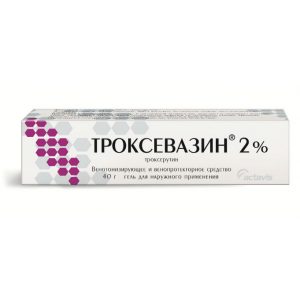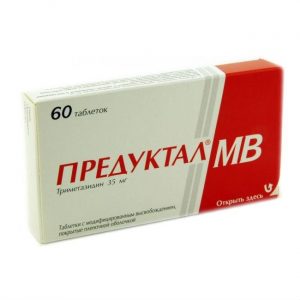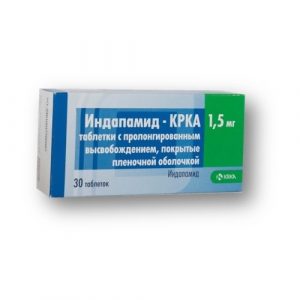Description
Description
Tablets are white or cream-white with a cream tint, flat cylindrical with bevel and chamfer.
Pharmacological action
The derivative of dihydropyridine is a blocker of “slow” calcium channels (BMCC) of the second generation, has an antianginal and hypotensive effect. By binding to dihydropyridine receptors, it blocks calcium channels, reduces the transmembrane transition of calcium ions to the cell (to a greater extent in vascular smooth muscle cells than in cardiomyocytes).
The antianginal effect is due to the expansion of the coronary and peripheral arteries and arterioles: with angina pectoris it reduces the severity of myocardial ischemia by expanding peripheral arterioles, reduces total peripheral vascular resistance (OPSS), reduces preload on the heart, and reduces myocardial oxygen demand. It expands the main coronary arteries and arterioles in the unchanged and ischemic zones of the myocardium, increases the flow of oxygen into the myocardium (especially with vasospastic angina pectoris) and prevents the development of coronary artery spasm (including that caused by smoking). In patients with stable angina pectoris, a single daily dose increases exercise tolerance, slows the development of angina pectoris and ischemic depression of the ST segment, and reduces the frequency of angina attacks and consumption of nitroglycerin and other nitrates.
Has a prolonged dose-dependent hypotensive effect. The antihypertensive effect is due to a direct vasodilating effect on the smooth muscles of blood vessels. In case of arterial hypertension, a single dose provides a clinically significant decrease in blood pressure (BP) over 24 hours (in the patient s lying and standing position). Orthostatic hypotension with the appointment of amlodipine is quite rare. Does not cause a decrease in exercise tolerance, ejection fraction of the left ventricle. Reduces the degree of left ventricular myocardial hypertrophy, It has anti-atherosclerotic and cardioprotective effects in coronary heart disease (CHD). It does not affect myocardial contractility and conductivity, does not cause a reflex increase in heart rate (HR), inhibits platelet aggregation, increases glomerular filtration rate, and has a weak natriuretic effect. With diabetic nephropathy does not increase the severity of microalbuminuria. It does not have any adverse effect on the metabolism and concentration of blood plasma lipids and can be used in the treatment of patients with bronchial asthma, diabetes mellitus and gout. A significant decrease in blood pressure is observed after 6-10 hours, the duration of the effect is 24 hours. With prolonged therapy, the maximum decrease in blood pressure occurs 6-12 hours after taking amlodipine orally. If amlodipine is canceled after prolonged treatment, an effective decrease in blood pressure persists for 48 hours after the last dose. Then blood pressure indicators gradually return to their original level over 5-6 days.
Indications
Arterial hypertension (monotherapy or in combination with other antihypertensive drugs).
Stable angina pectoris and vasospastic angina (Prinzmetal angina) (monotherapy or in combination with other antihypertensive drugs).
Contraindications
Hypersensitivity to amlodipine, dihydropyridine derivatives and other components of the
drug severe arterial hypotension (systolic blood pressure less than 90 mmHg) srdlkardcollapse except for Prinzmetal angina)
clinically significant aortic stenosis
pregnancy and lactation
age up to 18 years (efficacy and safety not studied)
lactase deficiency, not erenosimost lactose, glucose-galactose malabsorption.
Use with caution in case of: impaired liver function, sinus node weakness syndrome (SSS) (severe bradycardia, tachycardia), chronic heart failure of a nonischemic etiology of a functional class III-IV according to NYHA classification, arterial hypotension, aortic stenosis, mitral stenosis, hypertrophic obstructive cardiomyopathy (GOKMP), acute myocardial infarction (and within 1 month after myocardial infarction), in old age.
Recommendations for use
Inside, the initial dose for the treatment of arterial hypertension and angina pectoris is 5 mg of the drug once a day. The maximum daily dose is 10 mg once.
With arterial hypertension, the maintenance dose may be 2, 5 – 5 mg (1/2 tablet of 5 mg – 1 tablet of 5 mg) per day.
With angina pectoris and vasospastic angina pectoris – 5-10 mg per day, once. In order to prevent angina attacks – 10 mg / day.
Amlodipine is prescribed with caution in patients with impaired liver function as a hypotensive agent, at an initial dose of 2.5 mg (1/2 tablet of 5 mg), and 5 mg as an antianginal drug.
In elderly patients, T1 / 2 of Amlodipine may increase and creatinine clearance (CC) may decrease. Dose changes are not required, but more careful monitoring of patients is necessary.
Dose changes are not required when given simultaneously with thiazide diuretics, beta-blockers, and angiotensin converting enzyme (ACE) inhibitors.
No dosage changes are required in patients with renal failure.
Composition
One tablet contains:
as an active ingredient:
amlodipine besilate – 13.8 mg, which amlodipine
excipients:
lactose monohydrate – 171.4 mg,
povidone – 6.4 mg,
crospovidone – 6.4 mg,
calcium stearate – 2.0 mg.
Side effects of
Classification of the incidence of side effects of the World Health Organization (WHO):
very often> 1/10
often> 1/100 to <1/10 sometimes> 1/1000 to <1/100 rarely from> 1/10000 to <1/1000 very rarely from <1/10000, including individual messages. From the cardiovascular system: often – palpitations, peripheral edema (swelling of the ankles and feet), flushing of blood to the skin of the face, sometimes – an excessive decrease in blood pressure is very rare – syncope, shortness of breath, vasculitis, orthostatic hypotension, development or worsening of heart failure , heart rhythm disturbances (including bradycardia, ventricular tachycardia and atrial fibrillation), myocardial infarction, chest pain. From the central and peripheral nervous system: often – headache, dizziness, increased fatigue, drowsiness sometimes – asthenia, general malaise, hypesthesia, paresthesia, peripheral neuropathy, tremor, insomnia, mood lability, unusual dreams, nervousness, depression, anxiety very rarely – migraine, increased sweating, apathy. From the digestive system: often – nausea, abdominal pain sometimes – vomiting, constipation or diarrhea, flatulence, dyspepsia, anorexia, dry mouth, thirst rarely – gum hyperplasia, increased appetite very rarely – pancreatitis, gastritis, jaundice (caused cholestasis), hyperbilirubinemia, increased activity of liver transaminases, hepatitis. From the hemopoietic organs: very rarely – thrombocytopenic purpura, leukopenia, thrombocytopenia. From the genitourinary system: sometimes – frequent urination, painful urination, nocturia, impotence, very rarely – dysuria, polyuria, gynecomastia. From the respiratory system: sometimes – shortness of breath, rhinitis, very rarely – cough. From the skin: rarely – dermatitis, very rarely – alopecia, xeroderma, “cold” sweat, a violation of skin pigmentation. Allergic reactions: pruritus, rash (including erythematous, maculopapular rash, urticaria), angioedema, erythema multiforme. From the musculoskeletal system: sometimes – muscle cramps, myalgia, arthralgia, back pain, arthrosis, rarely – myasthenia gravis. Other: sometimes – tinnitus, diplopia, accommodation disturbance, xerophthalmia, conjunctivitis, eye pain, chills, nosebleeds, very rarely – parosmia, hyperglycemia. Drug Interactions Amlodipine can be safely used to treat hypertension with thiazide diuretics, alpha-blockers, beta-blockers, or ACE inhibitors. In patients with stable angina pectoris, the drug can be combined with other antianginal drugs, for example, prolonged-action nitrates, beta-blockers, or short-acting nitrates. Amlodipine can be used simultaneously with non-steroidal anti-inflammatory drugs (NSAIDs) (especially indomethacin), antibacterial agents, and hypoglycemic agents for oral administration. It is possible to enhance the antianginal and hypotensive effects of BMCC when used together with thiazide and loop diuretics, verapamil, ACE inhibitors, beta-blockers and nitrates, as well as an increase in their hypotensive effect when used together with alpha-1-blockers, antipsychotics. Although a negative inotropic effect was not usually observed when studying amlodipine, nevertheless, some BMCC can increase the severity of the negative inotropic effect of antiarrhythmic drugs that cause a prolongation of the QT interval (for example, amiodarone and quinidine). A single dose of 100 mg of sildenafil in patients with essential hypertension does not affect the pharmacokinetics of amlodipine. Repeated use of amlodipine at a dose of 10 mg and atorvastatin at a dose of 80 mg is not accompanied by significant changes in the pharmacokinetics of atorvastatin. Ethanol (drinks containing alcohol): amlodipine, with a single and repeated use at a dose of 10 mg, does not affect the pharmacokinetics of ethanol. Antiviral agents (ritonavir) increase plasma concentrations of BMCC, including amlodipine. Antipsychotics and isoflurane – increased hypotensive effect of dihydropyridine derivatives. Calcium preparations may reduce the effect of BMCC. With the combined use of amlodipine with lithium preparations, an increase in the manifestation of neurotoxicity is possible (nausea, vomiting, diarrhea, ataxia, tremor, tinnitus). Amlodipine does not alter cyclosporine pharmacokinetics. Does not affect the concentration of digoxin in the blood serum and its renal clearance. Does not significantly affect the effect of warfarin (prothrombin time). Cimetidine does not affect the pharmacokinetics of amlodipine. In vitro studies, amlodipine does not affect the binding of digoxin, phenytoin, warfarin, and indomethacin to blood proteins. Grapefruit juice: simultaneous administration of 240 mg of grapefruit juice and 10 mg of amlodipine orally is not accompanied by a significant change in the pharmacokinetics of amlodipine. Overdose Symptoms: excessive peripheral vasodilation with a pronounced and possibly prolonged decrease in blood pressure, collapse, shock. Treatment: gastric lavage, the appointment of activated carbon, maintaining the function of the cardiovascular system, monitoring of indicators of the function of the heart and lungs, elevated, above the level of the head, the position of the lower extremities, control of the volume of circulating blood and urine output. To restore vascular tone – the use of vasoconstrictors (in the absence of contraindications to their use) in order to eliminate the effects of calcium channel blockade – intravenous administration of calcium gluconate. Hemodialysis is ineffective. Storage conditions Dry, the place protected from light, at a temperature not above 25 ° C. Keep out of the reach of children. The Expiration of is 3 years. Do not use after the expiry date. Deystvuyuschee substances amlodipine drugstore terms tablet form Appointment Adult doctor’s appointment Indications Hypertension, Angina




